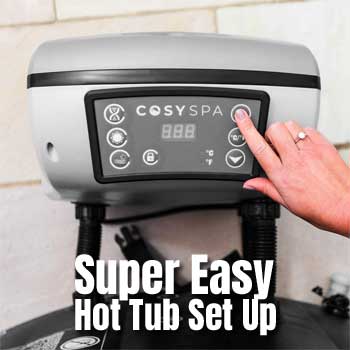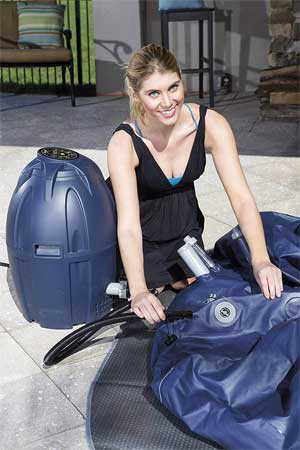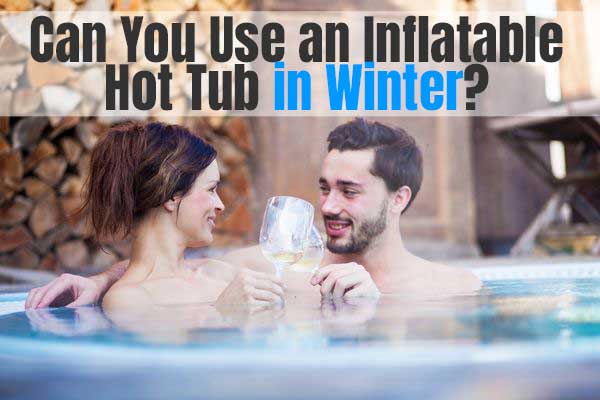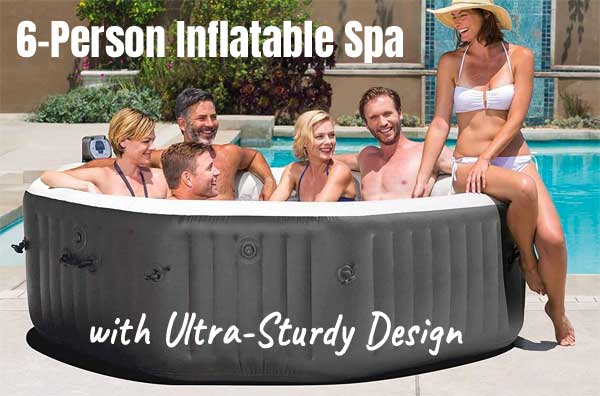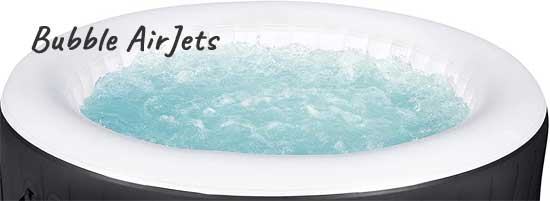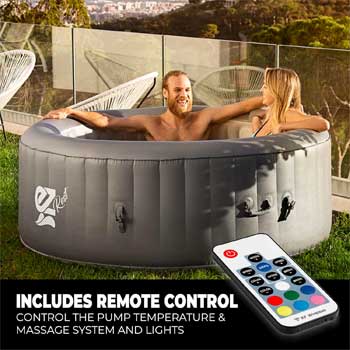Inflatable hot tubs provide a convenient and affordable option for relaxation at home. Plus, they are easy to set up and provide a soothing experience with their built-in jets. Furthermore, they are portable, low-maintenance and quiet.
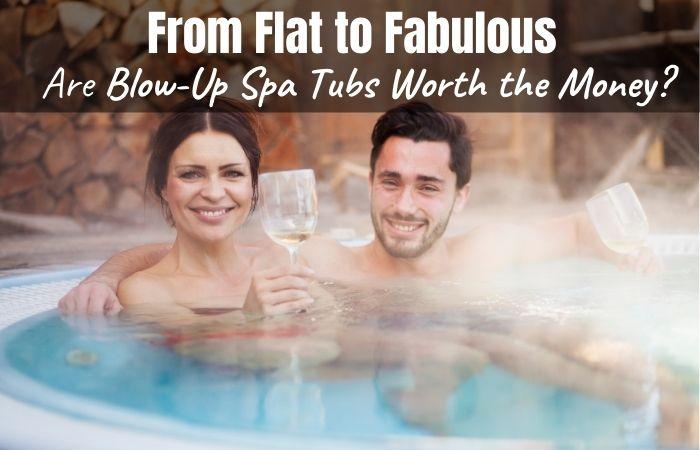
On the flip side, they typically only last 3-7 years, they have poor insulation and they don’t come with built-in seats. But are these low cost home spas worth the money? Let’s find out…
Pros:
- Affordability: Blow-up spas are generally much cheaper upfront.
- Portability: You can easily deflate and move them.
- Installation: They’re simpler to set up, often requiring no professional help.
Cons:
- Durability: They might not last as long as hard-sided versions.
- Heat Efficiency: Insulation can be inferior, leading to higher energy costs.
- Jets: Less powerful jets compared to some hard-shell spa models.
1. How Much Does a Blow-up Spa Cost?
Costs vary based on size, features, and brand. On average, you’re looking at around $400 to $1,500. In comparison to hard-sided spas, inflatable ones are typically more budget-friendly.

The electricity cost of running an inflatable hot tub varies depending on factors like the tub’s size, heater power, local electricity rates and how often you heat up your jacuzzi.
On average, cost can run from $10 to $50 per month. Larger tubs with more powerful heaters will generally have higher operating expenses. However, smaller jacuzzis with energy-efficient features require less power to run.
2. How Durable are Inflatable Spa Tubs?
Inflatable spa tub durability varies. Smaller tubs may last 3-5 years, while larger, premium sizes can endure 5-7 years or more with proper care. When it comes to durability, several factors influence their strength and longevity:
Material Quality: First off, long-lastingness comes down to materials used. Most inflatables are put together with heavy-duty PVC or similar textiles that resist punctures and abrasions. The thickness of the fabric also determines its strength. High-quality models use robust, puncture-resistant material, which enhances their robustness.
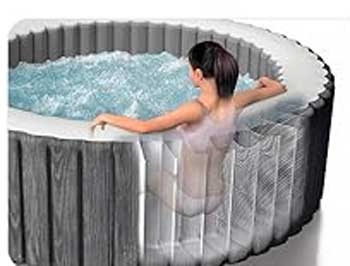
Construction: The fabrication method and seams are equally important. Well-constructed inflatable hot tubs have reinforced joints and multiple layers to enhance strength and longevity.
High-end models often employ advanced welding and bonding techniques to create airtight connections that withstand stress and pressure.
Reinforcements: Some inflatable hot tubs include additional reinforcements, such as fiber-tech construction or laminated PVC layers. These reinforcements provide extra structural support, making the spa more durable and rigid.
Care and Maintenance: Proper care and maintenance are essential to prolong the lifespan of a blow-up spa. Regular cleaning, water chemistry management, and avoiding sharp objects or pets near the spa can prevent damage.
Usage and Climate: Environmental conditions can impact durability. For instance, exposure to harsh weather, and extreme temperature fluctuations can affect the spa’s lifespan.
3. Are Portable Jacuzzis Easy to Set Up?
Inflatable spa tubs are known for their user-friendly setup. They generally don’t require professional help, saving you money and time. Here’s a breakdown:
Advantages:
- Ease of Setup: You can set up most inflatable tubs, like the Cosyspa, without professional assistance.
- Speed: Setup usually takes a few hours at most, depending on the model and size.
- No Permanent Installation: No need for plumbing or electrical modifications.
Disadvantages:
- Initial Effort: Filling the tub and getting the water temperature right can take some time.
- Maintenance: Regular maintenance like water chemistry and filter cleaning is necessary.
- Durability: Although easy to set up, they typically don’t last as long as hard-shell tubs.
Overall, the ease of setup and lower installation costs make inflatable spa tubs an attractive option for many.
4. What Kind of Maintenance do Inflatable Hot Tubs Require?
Maintenance for blow-up spa tubs is manageable but essential. Here’s what’s involved:
Cleaning: Regularly wipe the interior, check for debris, and clean the filter. Draining and thorough cleaning every few months is also recommended. See the 7 Cleaning Steps here.
Water Treatment: Maintain proper water chemistry by testing and adjusting pH, alkalinity, and sanitizer levels. You’ll need test strips or a kit.
5. How Long Does it Take to Heat Up Water in a Blow-up Spa?
The heating time of inflatable hot tubs varies, but overall, it takes 12-24 hours to warm up to your desired temperature, depending on the model. Find out more here.
Factors Affecting Heating Time:
- Tub Size: Smaller tubs heat quicker than larger ones because they don’t have as much water volume.
- Heater Power: Higher-wattage heaters can speed up the process.
- Ambient Temperature: Colder climates may require more time and energy.
Regarding energy efficiency, inflatable hot tubs may be less efficient than hard-shell tubs due to less insulation. However, you can improve efficiency by keeping the tub covered when not “on” and maintaining appropriate water temperature settings.
6. Can You Use an Inflatable Tub in Cold Weather?
Ultimately, while you can operate blow-up tubs in cold weather, the energy costs and heat retention are factors to take note of. A high-insulating cover and a protected area can help create a pleasant winter retreat.
Temperature Range:
- Most inflatable tubs work in temperatures as low as 40°F (4°C) or even lower.
- Some high-quality models are designed for winter use with better insulation.
7. Are Blow Up Spas Safe?
Yes, inflatable tubs are generally considered safe, and here’s why:
- Low Voltage: Most inflatable tubs use low-voltage systems, reducing electrical hazards.
- Easy Setup: The simple assembly process minimizes the risk of installation-related accidents.
- Portability: You can move the tub to a safe location, making it child-friendly when not in use.
- Slip-Resistant Features: Many inflatable tubs have non-slip surfaces for added safety.
Follow the manufacturer’s guidelines, use a ground fault circuit interrupter (GFCI), and practice common-sense safety measures. For example, keep the tub covered when not in use and lock it when unsupervised, especially with children around.
8. What to Know About Warranties & Customer Service:

Warranty: Most inflatable hot tubs come with warranties that typically range from 1 to 2 years, with premium models offering longer coverage, such as 5 years or more. The warranty generally covers manufacturing defects and certain components.
Customer Support: Manufacturers and retailers usually provide service to address any issues or questions, but sometimes via online. The quality of customer service can vary, so research reviews and reputations when choosing a brand.
Replacement Parts: Parts are generally available for inflatable hot tubs, and replacement filters are easy to buy. However, confirm with the manufacturer or retailer that they stock them.
9. How Noisy are the Spa Pumps & Jets?
The noise level of pumps and jets in inflatable hot tubs can range slightly. That said, they’re quieter in relation to traditional jacuzzis. Here’s why:
- Use smaller, less powerful pumps.
- Often use bubble air jets, thus reducing noise.
- Designed for residential use, keeping noise levels in mind.
10. Can You Use These Tubs Indoors?
Indoor use is possible, but consider these factors:
- Inflatable spa tubs can set up inside, provided you have enough space & a sturdy foundation.
- Supply good ventilation to manage humidity and moisture.
- Protect flooring with a waterproof barrier to prevent damage.
- Consider water drainage options for easy maintenance.
11. What Accessories & Features Come with Spas?
Here’s the equipment you can typically expect to find in the package:
Basic Accessories:
- Inflatable tub and liner
- Pump and heater unit
- Airjet or hydrojet system
- Control panel
- Cover (to maintain water temperature)
- Ground cloth to protect the tub’s bottom
- Repair kit in case of punctures
Additional Features: Some models, like the SereneLife EZ Rest, offer advanced features. For example, it comes with LED lighting for ambiance, water filtration systems, digital controls for temperature and jet settings. Plus, wireless connectivity for remote control.
Note: To see the differences between different brands and models, check out our handy hot tub comparison chart. You can quickly view different features and functions to find the best blow up spa tub for you.
Updated May 5, 2024

